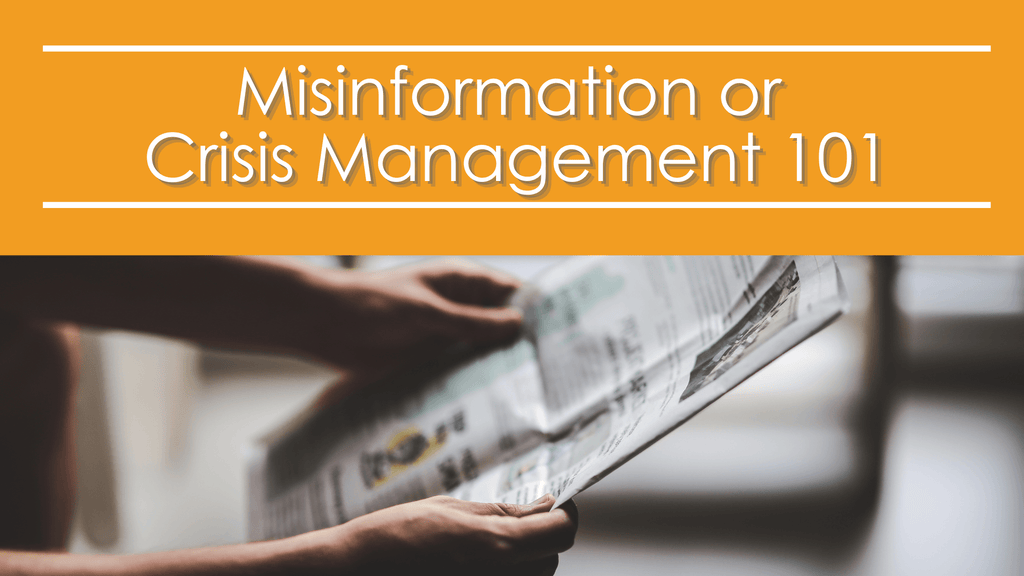
Misinformation or Crisis Management 101

3 Key Steps and a Case Study Review
In a world full of rapid growth and constant change, relaying accurate and reliable messages has become challenging. Misinformation or a crisis can strike at any moment, and if a company hasn’t prepared and doesn’t act quickly enough, a crisis could ensue, causing massive repercussions to its reputation.
A proactive approach is the best way to prevent or manage a crisis. There is much preparation businesses can do now to avoid a crisis after a destructive rumor or exacerbated situation.
- Develop and maintain a trustworthy and ethical reputation. For many reasons, not just for crisis management, this is vital. Businesses are encouraged to build a strong and reliable reputation with customers with two-way communication techniques (social media, public events, phone lines, etc.), transparency policies and practices (online reputation platforms, etc.), and strong employee relations.
- Allowing for two-way communication with customers encourages consumer-business dialogue. Customers feel heard, and when responded to accurately and in a timely manner, trust is built.
- Transparency. Transparency. Transparency. Audiences demand this today, and without it, businesses can be determined untrustworthy from the start. When an issue arises or even when something good happens, disclosing releasable and accurate details makes audiences feel involved and informed.
- Employee relations may seem strange to be included in this section. However, employees have friends and family outside of their employer. Employees are looked at as reliable sources when in crisis and otherwise. Establishing transparency and trust with this important audience is absolutely vital to maintain a strong outside reputation. This should be easy, as taking care of your employees is ethical and should be a best practice anyways.
- Establish a crisis communication plan. The time for this is not when crisis strikes. It is well before a crisis is even on the horizon. Creating a crisis communication plan should be on your business’ agenda from the start. Don’t know how to begin? We’ve got you covered. Start with outlining your business’ structure and who the point of contact is for accurate details from each department, bureau, or specialty. Then, establish a hierarchy of approval authorities and spokespersons. To complete the plan, brainstorm possible crises and develop tactics to overcome and manage them.
- Be the first voice to tell the story. Establish an accurate, truthful narrative of the crisis before someone else does. When implementing your crisis communication plan, you should have a jumpstart on details and who the approval authority and spokespersons are. This will help your business be the first to tell the world what happened in your crisis, beating all other “sources” in the news media and social media. Your business then becomes the focus and trustworthy storyteller for your crisis.
Case Study: Norfolk Southern Tragic Train Derailment, Lessons in Crisis Communication.
On February 3, 2023, East Palestine, Ohio, experienced a massive train derailment that sent dangerous fumes into the air. The train was carrying toxic and flammable materials that burned for days. The contamination resulted in residential evacuations. East Palestine residents experienced respiratory issues and water quality scares that caused a massive panic. The outrage from residents and immediate national attention catapulted the company into a nationwide crisis that will take them years if ever, to recover.
Local authorities, including the town’s government and first responders, maintained timely communication with residents. Evacuations were ordered, shelters were established, and press conferences were held. The National Transportation Safety Board issued statements about the derailment providing updates on the investigation and findings, as they were the determined point of contact for this, according to Norfolk Southern. Statements from Norfolk Southern became frequent approximately ten days after the crisis began.
Big takeaways:
- Norfolk Southern issued their first statement the following day, February 4. They sent a basic, informative statement to the media indicating the best point of contact for viable investigation updates. Breaking silence early portrays control of an active situation. Although short with minimal information, Norfolk Southern addressed the situation and provided an outlet for updates.
- A community town hall was planned, with the anticipated attendance of Norfolk Southern. The company did not attend. They failed to establish two-way communication with the grieving community. Although under investigation, showing up and hearing the community’s feedback is crucial to crisis management.
- Although not immediately after the crisis, statements from Norfolk Southern did occur after the derailment. Frequent updates, even when no update is available, continue to show that a company is diligently working on the crisis. Transparency is key. Several releases were issued providing updates about ten days after the derailment.
- Other issues pertaining to safety, policies, and regulations began to surface after the derailment. Instead of hiding mistakes, be transparent with your audience about it and rectify the issue quickly. The floodgates opened after the derailment for Norfolk Southern. One large-scale, devastating crisis resulted in many smaller crises that could have been potentially prevented.
A crisis can happen at any time. Prevention and preparation are key. Businesses are encouraged to mitigate potentially brewing issues and be transparent about shortfalls. Don’t be shy to share successes, too! Being transparent about both will help develop that relationship with your audiences.
If you need help with crisis communication, check out our services or contact us today.
You May Like

What I’ve Learned So Far In My PTE Internship
I can’t believe that I have been at this internship for more than a month now. Not having any experience at a PR firm, I wasn’t sure what I was getting into when I started. I was pretty nervous on my first day and didn’t really know what to expect

The Best Way to Become a Pro!
What I’ve learned so far at Pushing the Envelope, Inc. includes a thousand new things. I’ve written news releases, media alerts, put together presentations and so much more. I’ve also learned a great deal about graphic design, how to re-size photos and graphic images and how to incorporate creativity into

A Great Learning Experience
My experience with Pushing the Envelope (PTE) has been a great learning experience so far. It’s hard to believe that we are in November and it’s even harder to believe that I’m at the midpoint of my internship. Since joining, I have become familiar with PTE clients such as Six